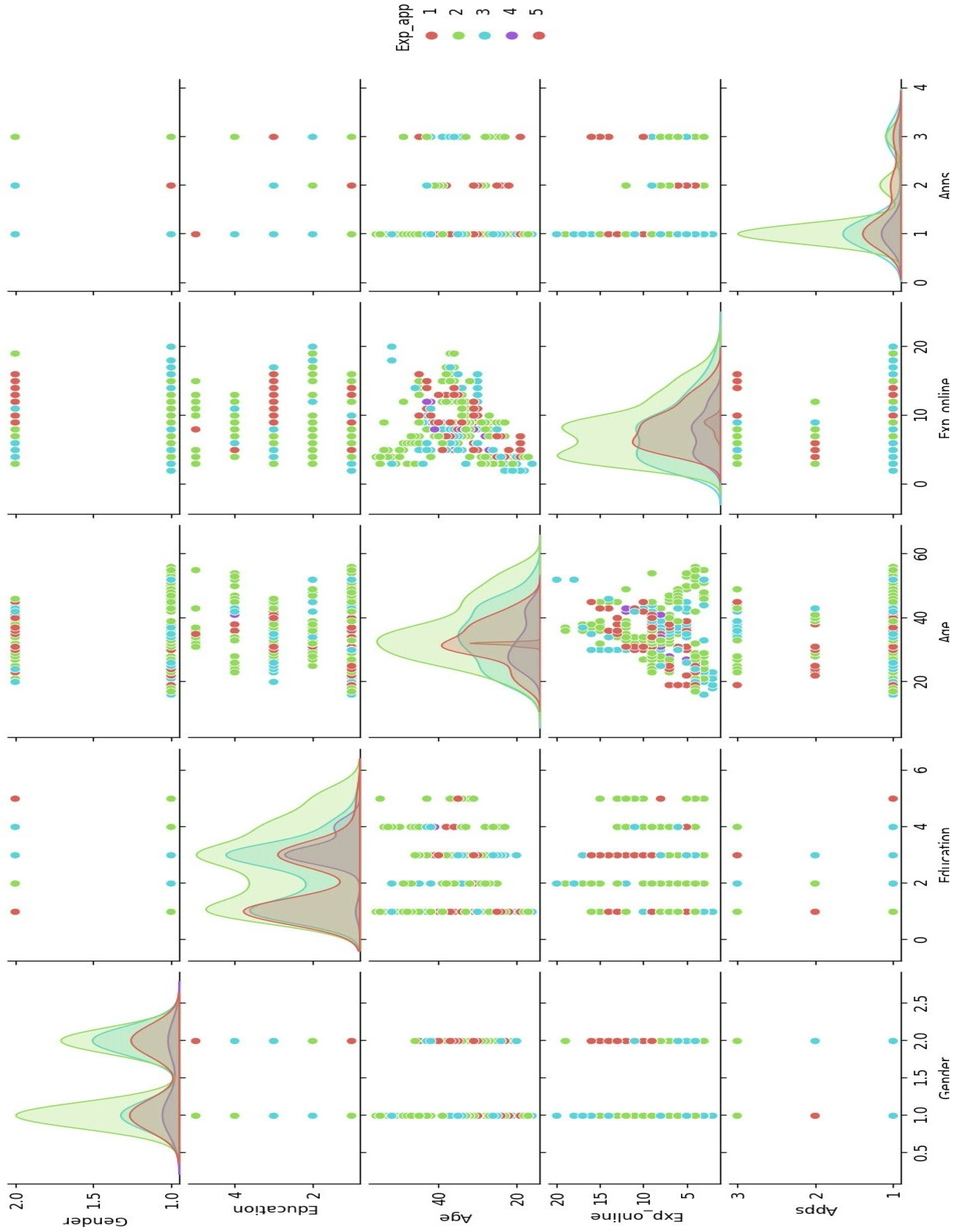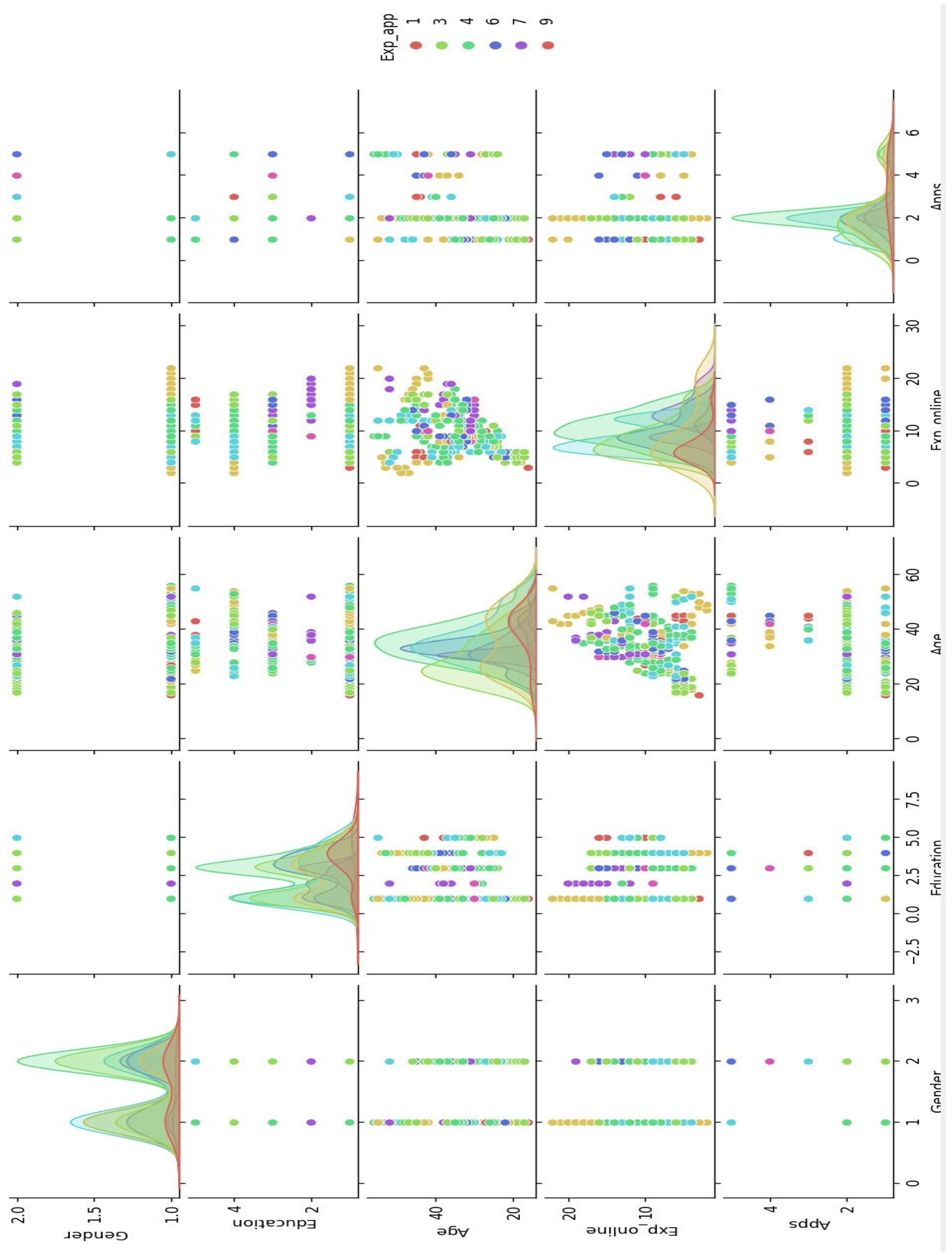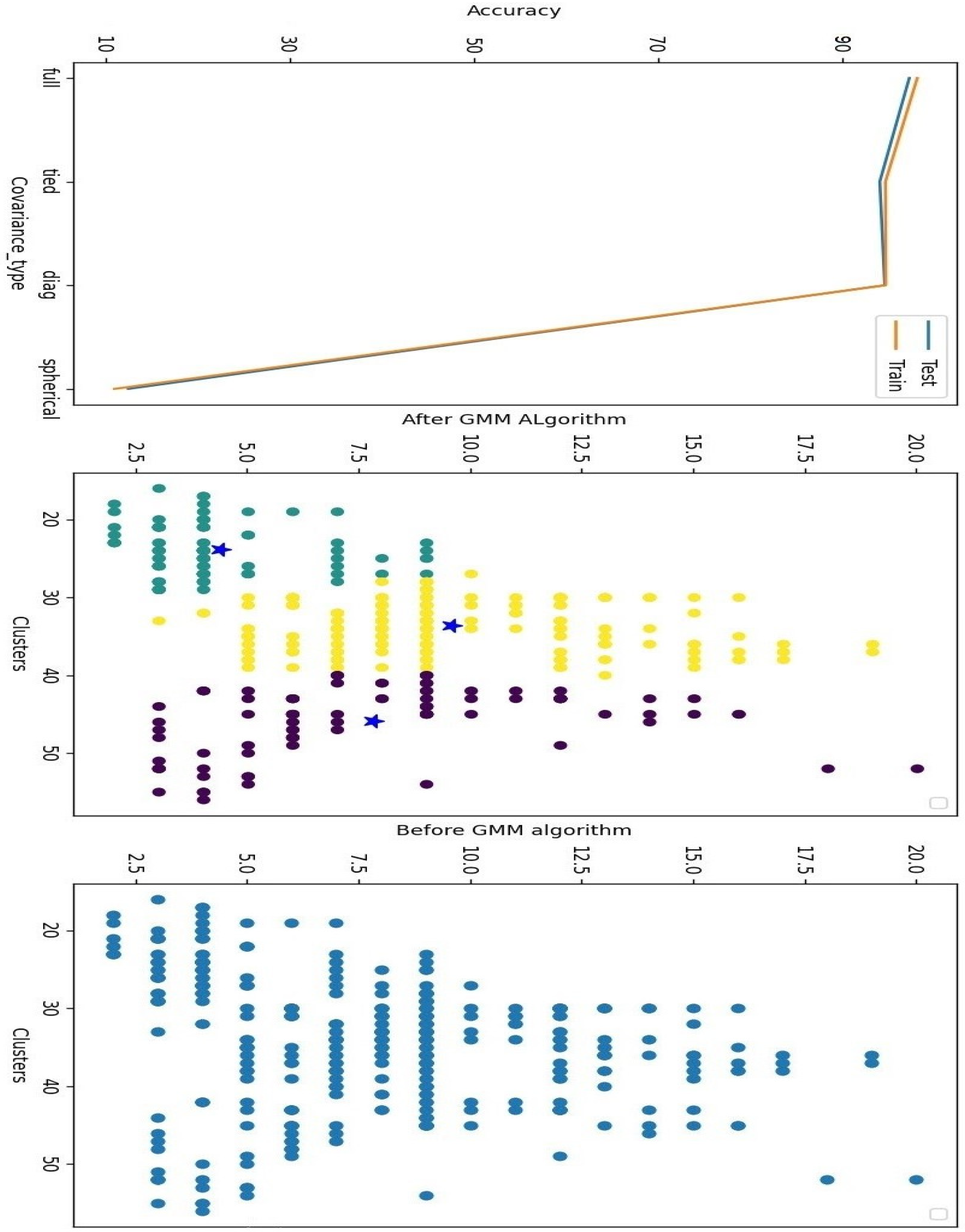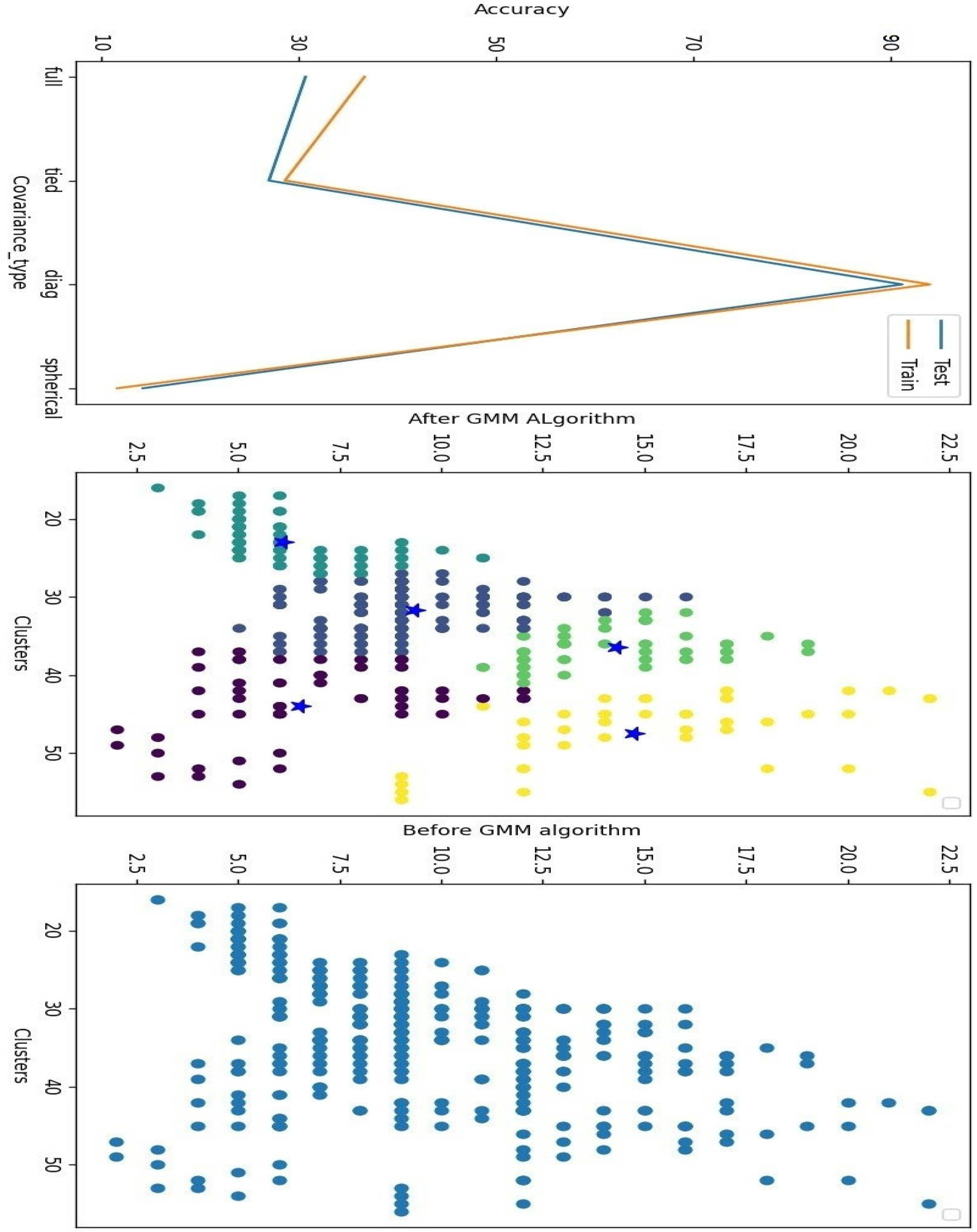Grocery Apps and Consumer Purchase Behavior: Application of Gaussian Mixture Model and Multi-Layer Perceptron Algorithm
Abstract
1. Introduction
2. Literature Review
2.1. Consumer Purchase Behavior
2.2. Grocery Shopping Mobile Apps
2.3. Application of Machine Learning in e-Commerce
3. Methodology
- (1).
- Import the data;
- (2).
- Data preprocessing;
- (3).
- Split the data into training and testing data;
- (4).
- Create a model;
- (5).
- Train the model;
- (6).
- Model clustering/Model prediction;
- (7).
- Accuracy of the model.
3.1. Gaussian Mixture Model Algorithm
3.2. Multi-Layer Perceptron Algorithm
3.3. Sample and Data Collection
4. Results
| Code 1. Model accuracy based on covariance type in GMM algorithm: |
| test_accuracy = [] |
| train_accuracy = [] |
| covariance_type = [] |
| for i in [“full”, “tied”, “diag”, “spherical”]: |
| model = GaussianMixture(covariance_type = i, n_components = 3 #5, random_state = 0) |
| model.fit(x_train, y_train) |
| y_predict = model.predict(x_test) |
| score = accuracy_score(y_test, y_predict) |
| test_accuracy.append(model.score(x_test, y_test)) |
| train_accuracy.append(model.score(x_train, y_train)) |
| covariance_type.append(i) |
| Code 2. Prediction based on MLP model |
| model = MLPRegressor(hidden_layer_sizes = (30, 40), activation = ‘relu’, solver = ‘adam’) |
| model.fit(x, y) |
| prediction = model.predict([[1, 3, 39, 5, 3], [2, 3, 20, 2, 2]]) |
| Code 3. Cross validation and overfitting |
| # cross validation and overfitting |
| reg = MLPRegressor() |
| cv_score = cross_val_score(reg, x, y, cv = 5) |
| mse = np.mean(cv_score) |
| print(“cross validation mse is: “, abs(mse)) |
| clf = MLPRegressor(hidden_layer_sizes = ( |
| 30, 40), activation = ‘relu’, solver = ‘adam’) |
| scores = cross_val_score(clf, x, y, cv=5) |
| print(f”Score is: {scores}”) |
| Code 4. Confusion matrix, ROC curve and AUC |
| from sklearn.metrics import confusion_matrix, classification_report |
| from sklearn.metrics import roc_curve |
| print(confusion_matrix(y_test, labels)) |
| print(classification_report(y_test, labels)) |
| labels_prob = model.predict_proba(x_test)[:, 1] |
| fpr, tpr, thresholds = roc_curve(labels, labels_prob) |
| print(f” AUC is: {roc_auc_score(labels, labels_prob)}”) |
5. Discussion
6. Conclusions
6.1. Managerial Implication
6.2. Limitations and Suggestions
Author Contributions
Funding
Data Availability Statement
Conflicts of Interest
References
- Al Amin, Md, Md Shamsul Arefin, Imran Hossain, Md Rakibul Islam, Nayeema Sultana, and Md Nazmul Hossain. 2022. Evaluating the determinants of customers’ mobile grocery shopping application (MGSA) adoption during COVID-19 pandemic. Journal of Global Marketing 35: 228–47. [Google Scholar] [CrossRef]
- Alshurideh, Muhammad, Barween Al Kurdi, Said A Salloum, Ibrahim Arpaci, and Mostafa Al-Emran. 2020. Predicting the actual use of m-learning systems: A comparative approach using PLS-SEM and machine learning algorithms. Interactive Learning Environments, 1–15. [Google Scholar] [CrossRef]
- Altay, Burak Can, Abdullah Okumuş, and Burcu Adıgüzel Mercangöz. 2022. An intelligent approach for analyzing the impacts of the COVID-19 pandemic on marketing mix elements (7Ps) of the on-demand grocery delivery service. Complex & Intelligent Systems 8: 129–40. [Google Scholar]
- Andati, Patrick, Eucabeth Majiwa, Marther Ngigi, Robert Mbeche, and Josiah Ateka. 2022. Determinants of Adoption of Climate Smart Agricultural Technologies among Potato Farmers in Kenya: Does entrepreneurial orientation play a role? Sustainable Technology and Entrepreneurship 1: 100017. [Google Scholar] [CrossRef]
- Baarsma, Barbara, and Jesse Groenewegen. 2021. COVID-19 and the Demand for Online Grocery Shopping: Empirical Evidence from the Netherlands. De Economist 169: 407–21. [Google Scholar] [CrossRef]
- Bouzari, Parisa, Aidin Salamzadeh, Maryam Soleimani, and Pejman Ebrahimi. 2021. Online Social Networks and Women’s Entrepreneurship: A Comparative Study between Iran and Hungary. Journal of Women’s Entrepreneurship and Education, 61–75. [Google Scholar] [CrossRef]
- Bruwer, Lee-Andra, Nkosivile Welcome Madinga, and Nqobile Bundwini. 2021. Smart shopping: The adoption of grocery shopping apps. British Food Journal 124: 1383–99. [Google Scholar] [CrossRef]
- Chakraborty, Debarun. 2019. Indian shoppers’ attitude towards grocery shopping apps: A survey conducted on smartphone users. Metamorphosis 18: 83–91. [Google Scholar] [CrossRef]
- Chakraborty, Debarun, Shakti Bodh Bhatnagar, Wendrila Biswas, and Ajay Kumar Khatua. 2022. What Drives People to Adopt Grocery Apps? The Moderating Role of Household Size. Business Perspectives and Research. Online First. Available online: https://journals.sagepub.com/doi/abs/10.1177/22785337221091640 (accessed on 9 March 2022).
- de Magalhães, David José Ahouagi Vaz. 2021. Analysis of critical factors affecting the final decision-making for online grocery shopping. Research in Transportation Economics 87: 101088. [Google Scholar] [CrossRef]
- Desai, Meha, and Manan Shah. 2021. An anatomization on breast cancer detection and diagnosis employing multi-layer perceptron neural network (MLP) and Convolutional neural network (CNN). Clinical eHealth 4: 1–11. [Google Scholar] [CrossRef]
- Dharmesti, Maria, Theresia Rasika Seta Dharmesti, Sarah Kuhne, and Park Thaichon. 2019. Understanding online shopping behaviours and purchase intentions amongst millennials. Young Consumers 22: 152–67. [Google Scholar] [CrossRef]
- Driediger, Fabian, and Veera Bhatiasevi. 2019. Online grocery shopping in Thailand: Consumer acceptance and usage behavior. Journal of Retailing and Consumer Services 48: 224–37. [Google Scholar] [CrossRef]
- Ebrahimi, Pejman, Aidin Salamzadeh, Maryam Soleimani, Seyed Mohammad Khansari, Hadi Zarea, and Maria Fekete-Farkas. 2022a. Startups and Consumer Purchase Behavior: Application of Support Vector Machine Algorithm. Big Data and Cognitive Computing 6: 34. [Google Scholar] [CrossRef]
- Ebrahimi, Pejman, Datis Khajeheian, and Maria Fekete-Farkas. 2021a. A SEM-NCA Approach towards Social Networks Marketing: Evaluating Consumers’ Sustainable Purchase Behavior with the Moderating Role of Eco-Friendly Attitude. International Journal of Environmental Research and Public Health 18: 13276. [Google Scholar] [CrossRef]
- Ebrahimi, Pejman, Datis Khajeheian, Maryam Soleimani, Abbas Gholampour, and Maria Fekete-Farkas. 2022b. User engagement in social network platforms: What key strategic factors determine online consumer purchase behaviour? Economic Research-Ekonomska Istraživanja, 1–32. Available online: https://www.tandfonline.com/doi/full/10.1080/1331677X.2022.2106264 (accessed on 6 August 2022).
- Ebrahimi, Pejman, Khadija Aya Hamza, Eva Gorgenyi-Hegyes, Hadi Zarea, and Maria Fekete-Farkas. 2021b. Consumer knowledge sharing behavior and consumer purchase behavior: Evidence from E-commerce and online retail in Hungary. Sustainability 13: 10375. [Google Scholar] [CrossRef]
- Ebrahimi, Pejman, Marjan Basirat, Ali Yousefi, Md Nekmahmud, Abbas Gholampour, and Maria Fekete-Farkas. 2022c. Social Networks Marketing and Consumer Purchase Behavior: The Combination of SEM and Unsupervised Machine Learning Approaches. Big Data and Cognitive Computing 6: 35. [Google Scholar] [CrossRef]
- Ebrahimi, Pejman, Mohammad Naim Hasani, Aidin Salamzadeh, Seyed Mohammad Khansari, and Maria Fekete-Farkas. 2022d. A machine learning decision tree model to predict consumer purchase behaviour: A microeconomics view from online social platforms in Iran. International Journal of Business and globalization. in press. [Google Scholar]
- Fagerstrøm, Asle, Niklas Eriksson, and Valdimar Sigurdsson. 2020. Investigating the impact of Internet of Things services from a smartphone app on grocery shopping. Journal of Retailing and Consumer Services 52: 101927. [Google Scholar] [CrossRef]
- Fekete-Farkas, Maria, Abbas Gholampour, Parisa Bouzari, Hadi Jarghooiyan, and Pejman Ebrahimi. 2021. How gender and age can affect consumer purchase behavior? Evidence from A microeconomic perspective from Hungary. AD-Minister, 25–46. Available online: http://www.scielo.org.co/scielo.php?script=sci_arttext&pid=S1692-02792021000200025 (accessed on 28 August 2020). [CrossRef]
- Flacandji, Michaël, and Mariana Vlad. 2022. The relationship between retailer app use, perceived shopping value and loyalty: The moderating role of deal proneness. International Journal of Retail & Distribution Management 50: 981–95. [Google Scholar]
- Garcia, Jorge Mazza, Otávio Bandeira De Lamônica Freire, Eduardo Biagi Almeida Santos, and Josmar Andrade. 2020. Factors affecting satisfaction and loyalty to online group buying. Revista de Gestão 27: 211–28. [Google Scholar] [CrossRef]
- Hallikainen, Heli, Milena Luongo, Amandeep Dhir, and Tommi Laukkanen. 2022. Consequences of personalized product recommendations and price promotions in online grocery shopping. Journal of Retailing and Consumer Services 69: 103088. [Google Scholar] [CrossRef]
- Horst, Sven-Ove, Aidin Salamzadeh, Pejman Ebrahimi, and Shaghayegh Kolli. 2021. Co-Creation in Provider Side for Developing Innovative Services: How New Technology-Based Firms Benefit from Social Media Platforms. Nordic Journal of Media Management 2: 109–26. [Google Scholar]
- Hsu, Tsuen-Ho, and Jia-Wei Tang. 2020. Development of hierarchical structure and analytical model of key factors for mobile app stickiness. Journal of Innovation & Knowledge 5: 68–79. [Google Scholar]
- Ilyuk, Veronika. 2018. Like throwing a piece of me away: How online and in-store grocery purchase channels affect consumers’ food waste. Journal of Retailing and Consumer Services 41: 20–30. [Google Scholar] [CrossRef]
- Jagtap, Santosh T., Khongdet Phasinam, Thanwamas Kassanuk, Subhesh Saurabh Jha, Tanmay Ghosh, and Chetan M. Thakar. 2022. Towards application of various machine learning techniques in agriculture. Materials Today: Proceedings 51: 793–97. [Google Scholar] [CrossRef]
- Khajeheian, Datis, and Pejman Ebrahimi. 2021. Media branding and value co-creation: Effect of user participation in social media of newsmedia on attitudinal and behavioural loyalty. European Journal of International Management 16: 499–528. [Google Scholar] [CrossRef]
- Kim, Hyungjoon. 2021. Use of Mobile Grocery Shopping Application: Motivation and Decision-Making Process among South Korean Consumers. Journal of Theoretical and Applied Electronic Commerce Research 16: 2672–93. [Google Scholar] [CrossRef]
- Kureshi, Sonal, and Sujo Thomas. 2019. Online grocery retailing–exploring local grocers beliefs. International Journal of Retail & Distribution Management 47: 157–85. [Google Scholar]
- Llorens, Miguel, and Adolfo Hernández. 2021. A study on the downloading intention of fashion retailers’ apps. Journal of Marketing Analytics 9: 349–62. [Google Scholar] [CrossRef]
- Maia, Claudia, Guilherme Lunardi, Andre Longaray, and Paulo Munhoz. 2018. Factors and characteristics that influence consumers’ participation in social commerce. Revista de Gestão 25: 194–211. [Google Scholar] [CrossRef]
- Menon, Lakshmi, Dripta Roy Choudhury, Rimante Ronto, Rupali Sengupta, Sangeeta Kansal, and Neha Rathi. 2022. Transformation in culinary behaviour during the COVID-19 pandemic: In-depth interviews with food gatekeepers in urban India. Appetite 172: 105948. [Google Scholar] [CrossRef] [PubMed]
- Mondal, Jalaluddin, and Somnath Chakrabarti. 2021. The abandonment behaviour of the branded app consumer: A study using interpretive structural modelling approach. Journal of Retailing and Consumer Services 63: 102695. [Google Scholar] [CrossRef]
- Ni, Lingling, Dong Wang, Jianfeng Wu, Yuankun Wang, Yuwei Tao, Jianyun Zhang, and Jiufu Liu. 2020. Streamflow forecasting using extreme gradient boosting model coupled with Gaussian mixture model. Journal of Hydrology 586: 124901. [Google Scholar] [CrossRef]
- Pallathadka, Harikumar, Malik Mustafa, Domenic T. Sanchez, Guna Sekhar Sajja, Sanjeev Gour, and Mohd Naved. 2021. Impact of machine learning on management, healthcare and agriculture. Materials Today: Proceedings. in press. [Google Scholar] [CrossRef]
- Pandey, Shweta, Deepak Chawla, and Sandeep Puri. 2021. Food delivery apps (FDAs) in Asia: An exploratory study across India and the Philippines. British Food Journal 124: 657–78. [Google Scholar] [CrossRef]
- Podsakoff, Philip M., Scott B. MacKenzie, Jeong-Yeon Lee, and Nathan P. Podsakoff. 2003. Common method biases in behavioral research: A critical review of the literature and recommended remedies. Journal of Applied Psychology 88: 879. [Google Scholar] [CrossRef]
- Rana, Arti, Arvind Singh Rawat, Anchit Bijalwan, and Himanshu Bahuguna. 2018. Application of multi layer (perceptron) artificial neural network in the diagnosis system: A systematic review. Paper presented at 2018 International Conference on Research in Intelligent and Computing in Engineering (RICE), San Salvador, El Salvador, August 22–24; pp. 1–6. [Google Scholar]
- Rinaldi, Chiara, Marlene D’Aguilar, and Matt Egan. 2022. Understanding the Online Environment for the Delivery of Food, Alcohol and Tobacco: An Exploratory Analysis of ‘Dark Kitchens’ and Rapid Grocery Delivery Services. International Journal of Environmental Research and Public Health 19: 5523. [Google Scholar] [CrossRef]
- Sarker, Iqbal H. 2021. Machine learning: Algorithms, real-world applications and research directions. SN Computer Science 2: 1–21. [Google Scholar] [CrossRef]
- Segovia, Michelle, Jasper Grashuis, and Theodoros Skevas. 2021. Consumer preferences for grocery purchasing during the COVID-19 pandemic: A quantile regression approach. British Food Journal. ahead-of-print. [Google Scholar] [CrossRef]
- Singh, Pratibha, Manali Gupta, Amresh Kumar, Pallab Sikdar, and Neena Sinha. 2021. E-Grocery retailing mobile application: Discerning determinants of repatronage intentions in an emerging economy. International Journal of Human–Computer Interaction 37: 1783–98. [Google Scholar] [CrossRef]
- Sreeram, Anusha, Ankit Kesharwani, and Sneha Desai. 2017. Factors affecting satisfaction and loyalty in online grocery shopping: An integrated model. Journal of Indian Business Research 9: 107–32. [Google Scholar] [CrossRef]
- Statista. 2022. Number of Facebook Users in Hungary from September 2018 to January 2022. Available online: https://www.statista.com/statistics/1029770/facebook-users-hungary/ (accessed on 1 March 2021).
- Tandon, Anushree, Puneet Kaur, Yogesh Bhatt, Matti Mäntymäki, and Amandeep Dhir. 2021. Why do people purchase from food delivery apps? A consumer value perspective. Journal of Retailing and Consumer Services 63: 102667. [Google Scholar] [CrossRef]
- Tax, Niek, Kees Jan de Vries, Mathijs de Jong, Nikoleta Dosoula, Bram van den Akker, Jon Smith, Olivier Thuong, and Lucas Bernardi. 2021. Machine learning for fraud detection in e-Commerce: A research agenda. In International Workshop on Deployable Machine Learning for Security Defense. Cham: Springer, pp. 30–54. [Google Scholar]
- Xu, Yuanjin, Fei Li, and Armin Asgari. 2022. Prediction and optimization of heating and cooling loads in a residential building based on multi-layer perceptron neural network and different optimization algorithms. Energy 240: 122692. [Google Scholar] [CrossRef]
- Yi, Hong, Xue Meng, Yuting Linghu, and Ziyu Zhang. 2022. Can financial capability improve entrepreneurial performance? Evidence from rural China. Economic Research-Ekonomska Istraživanja, 1–20. Available online: https://www.tandfonline.com/doi/full/10.1080/1331677X.2022.2091631 (accessed on 12 July 2022). [CrossRef]
- Zhou, Lichun. 2020. Product advertising recommendation in e-commerce based on deep learning and distributed expression. Electronic Commerce Research 20: 321–42. [Google Scholar] [CrossRef]





| Precision | Recall (Sensitivity) | F1 Score | Support | |
|---|---|---|---|---|
| Wolt (0) | 0.97 | 0.98 | 0.97 | 71 |
| Foodpanda (1) | 0.95 | 0.91 | 0.92 | 23 |
| Average/Total | 0.96 | 0.94 | 0.94 | 94 |
Publisher’s Note: MDPI stays neutral with regard to jurisdictional claims in published maps and institutional affiliations. |
© 2022 by the authors. Licensee MDPI, Basel, Switzerland. This article is an open access article distributed under the terms and conditions of the Creative Commons Attribution (CC BY) license (https://creativecommons.org/licenses/by/4.0/).
Share and Cite
Salamzadeh, A.; Ebrahimi, P.; Soleimani, M.; Fekete-Farkas, M. Grocery Apps and Consumer Purchase Behavior: Application of Gaussian Mixture Model and Multi-Layer Perceptron Algorithm. J. Risk Financial Manag. 2022, 15, 424. https://doi.org/10.3390/jrfm15100424
Salamzadeh A, Ebrahimi P, Soleimani M, Fekete-Farkas M. Grocery Apps and Consumer Purchase Behavior: Application of Gaussian Mixture Model and Multi-Layer Perceptron Algorithm. Journal of Risk and Financial Management. 2022; 15(10):424. https://doi.org/10.3390/jrfm15100424
Chicago/Turabian StyleSalamzadeh, Aidin, Pejman Ebrahimi, Maryam Soleimani, and Maria Fekete-Farkas. 2022. "Grocery Apps and Consumer Purchase Behavior: Application of Gaussian Mixture Model and Multi-Layer Perceptron Algorithm" Journal of Risk and Financial Management 15, no. 10: 424. https://doi.org/10.3390/jrfm15100424
APA StyleSalamzadeh, A., Ebrahimi, P., Soleimani, M., & Fekete-Farkas, M. (2022). Grocery Apps and Consumer Purchase Behavior: Application of Gaussian Mixture Model and Multi-Layer Perceptron Algorithm. Journal of Risk and Financial Management, 15(10), 424. https://doi.org/10.3390/jrfm15100424









